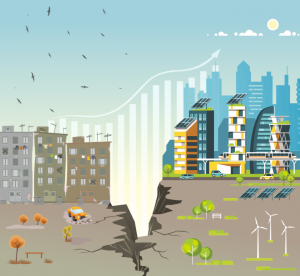
New statistical guidance launched today by UNECE will strengthen countries’ ability to measure poverty through improved data disaggregation – a critical step to meeting the first of the Sustainable Development Goals, SDG 1, “end poverty in all its forms everywhere”.
Poverty is complex. It is not just about a lack of money. It is expressed through social marginalization and exclusion, poor living conditions, and uneven access to social, financial and environmental resources and employment opportunities.
Different groups in society have different risks of poverty, and experience poverty in a range of ways. Regardless of how accurate national-level measures of poverty are, their usefulness is limited if they mask disparities within societies. Granular data are needed: data which break down the numbers into relevant groups to shine a light on who is experiencing or at risk of poverty in each of its forms. Only with this kind of disaggregated information can decision-makers or donors craft policies and programmes to address and alleviate poverty, and direct support where it is most needed.
The new publication, Poverty measurement: Guide to data disaggregation, developed by a UNECE Task Force of 30 statistical experts from member countries and international organizations led by Statistics Austria, builds on the 2017 UNECE Guide on Poverty Measurement.
Countries have shown increased interest in developing disaggregated national poverty measures. Spain, for example, has used a novel combination of data sources (census data and tax registers) to produce municipality-level income indicators, providing evidence for local decision-making. The 2020 National Survey of Household Income and Expenditure in Mexico, with a sample of more than 100,000 households, emphasized collection of data on vulnerable groups such as children, youth and elderly people, recent migrants, people with disabilities and ethnic minorities, with enough detail to allow construction of separate estimates for urban and rural areas. The survey permitted analysis of the poverty implications of the Covid-19 crisis for risk groups among the Mexican population.
A central pledge of the 2030 Agenda for Sustainable Development is to reach the furthest behind first and to leave no one behind – yet the most vulnerable or disadvantaged groups are often the hardest to identify and risk being underrepresented in statistical surveys or other data sources. This includes undocumented migrants, people without a fixed address, people living in institutions such as older people’s care homes, children’s homes and prisons, and marginalized ethnic minority groups, among others.
The new UNECE publication is designed to improve methodologies to help identify disadvantaged or vulnerable members of society, who often experience the highest levels of poverty. The recommended priority types of disaggregation cover, among others, age, sex, disability status, migratory status and ethnicity. The Guide also addresses methodological challenges and helps improve the quality and comparability of poverty measures, examining topics such as the measurement of intra-household sharing of resources, medical expenditures related to disability, housing wealth, imputed rent, social transfers in kind, and others. The Guide pays special attention to assessing and improving survey methods, including for hard-to-reach groups and populations living in institutions.
Statisticians have long argued that producing reliable statistical indicators disaggregated along many dimensions implies extra demands for greater sample sizes, over-coverage of small groups, and adaptation of survey tools to the special needs of certain respondents. These requirements make data collection more expensive and challenging. The Guide therefore calls for strong legal and policy processes to support statistical offices in producing disaggregated poverty measures, which cannot be achieved through methodological changes alone.
The Guide also highlights several pending problems in poverty measurement which will need to be tackled by the international statistical community: measuring non-monetary resources, measuring needs, assessing the impact of social transfers, using administrative data sources, and measuring changes in poverty over time, to name a few.